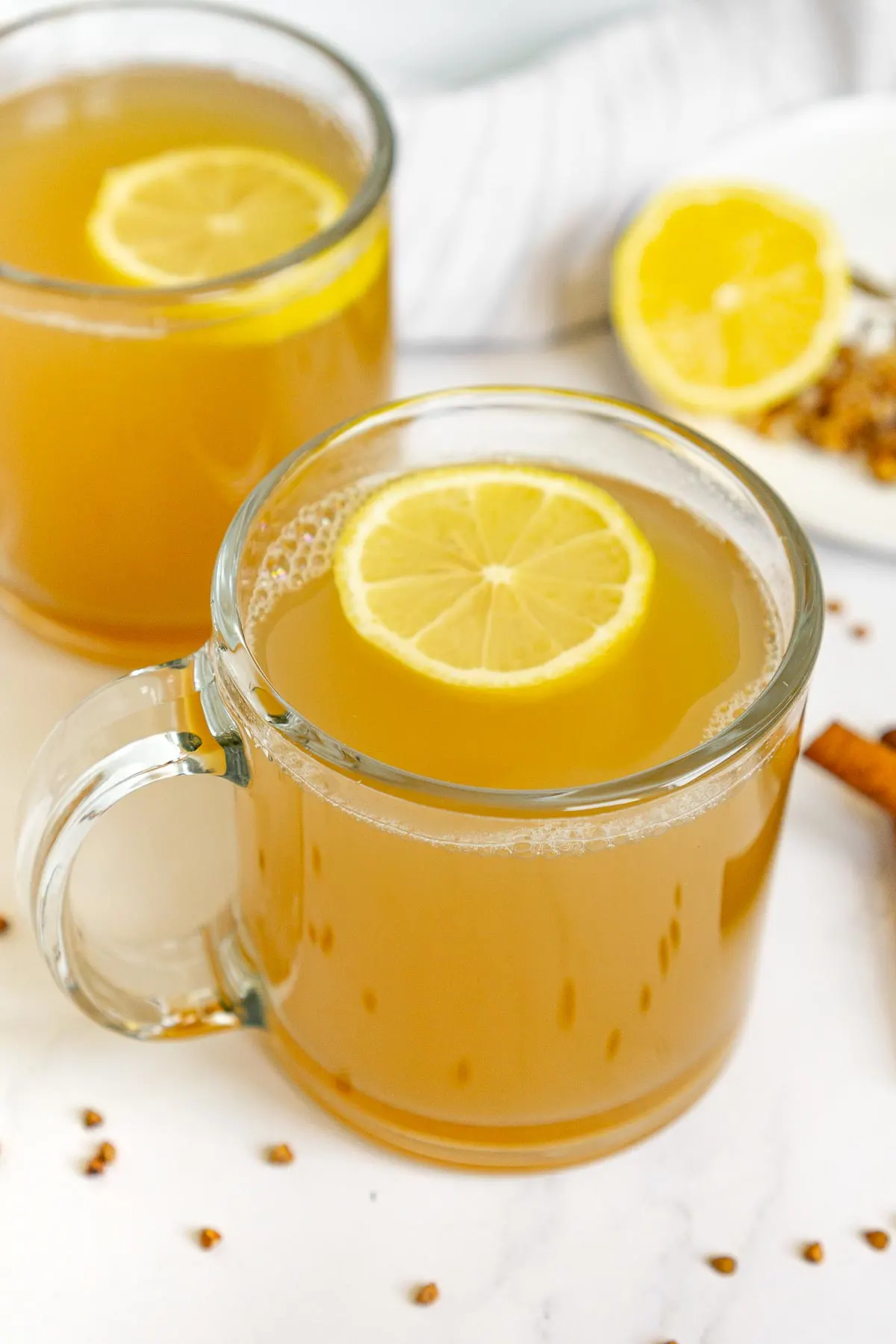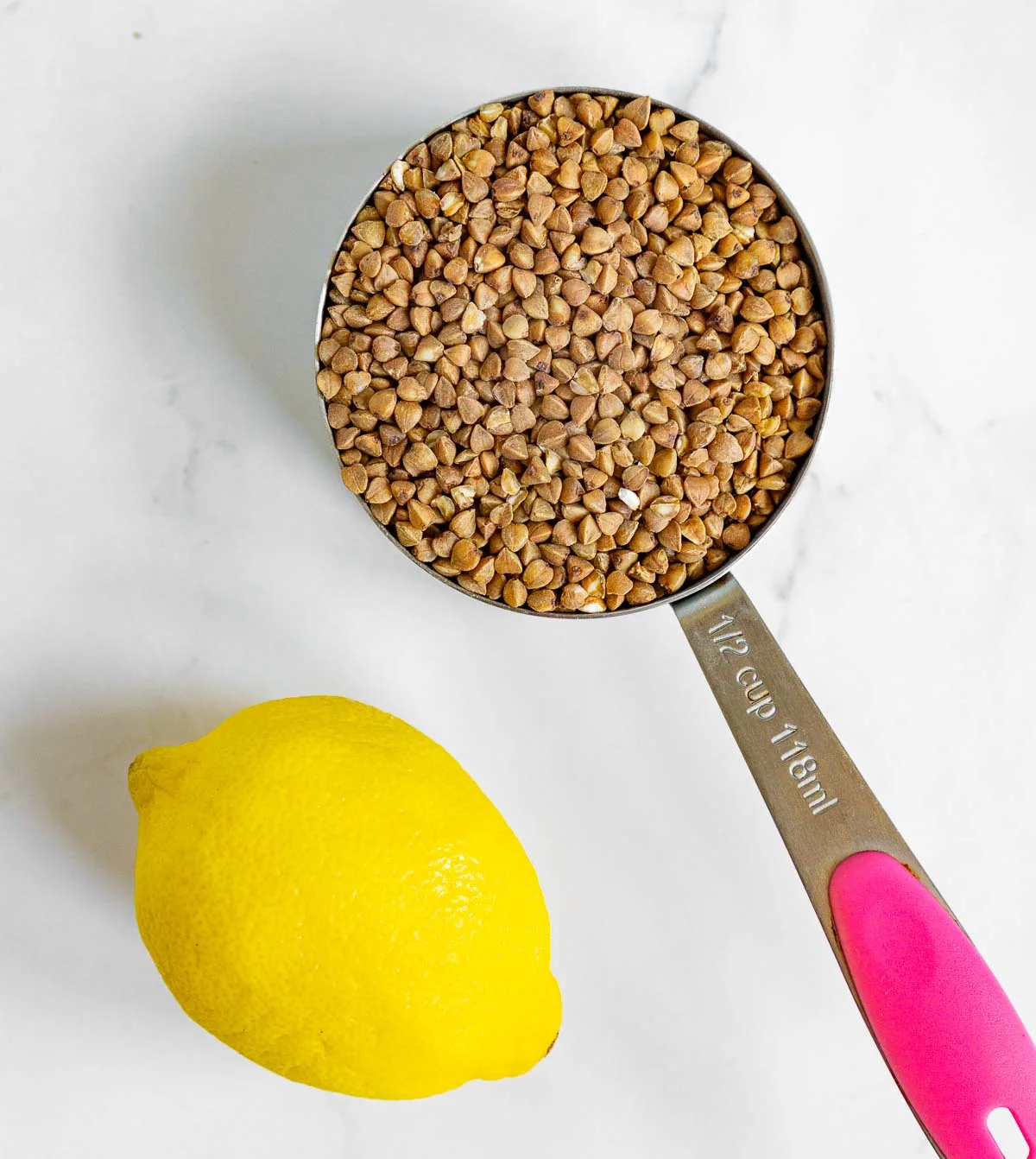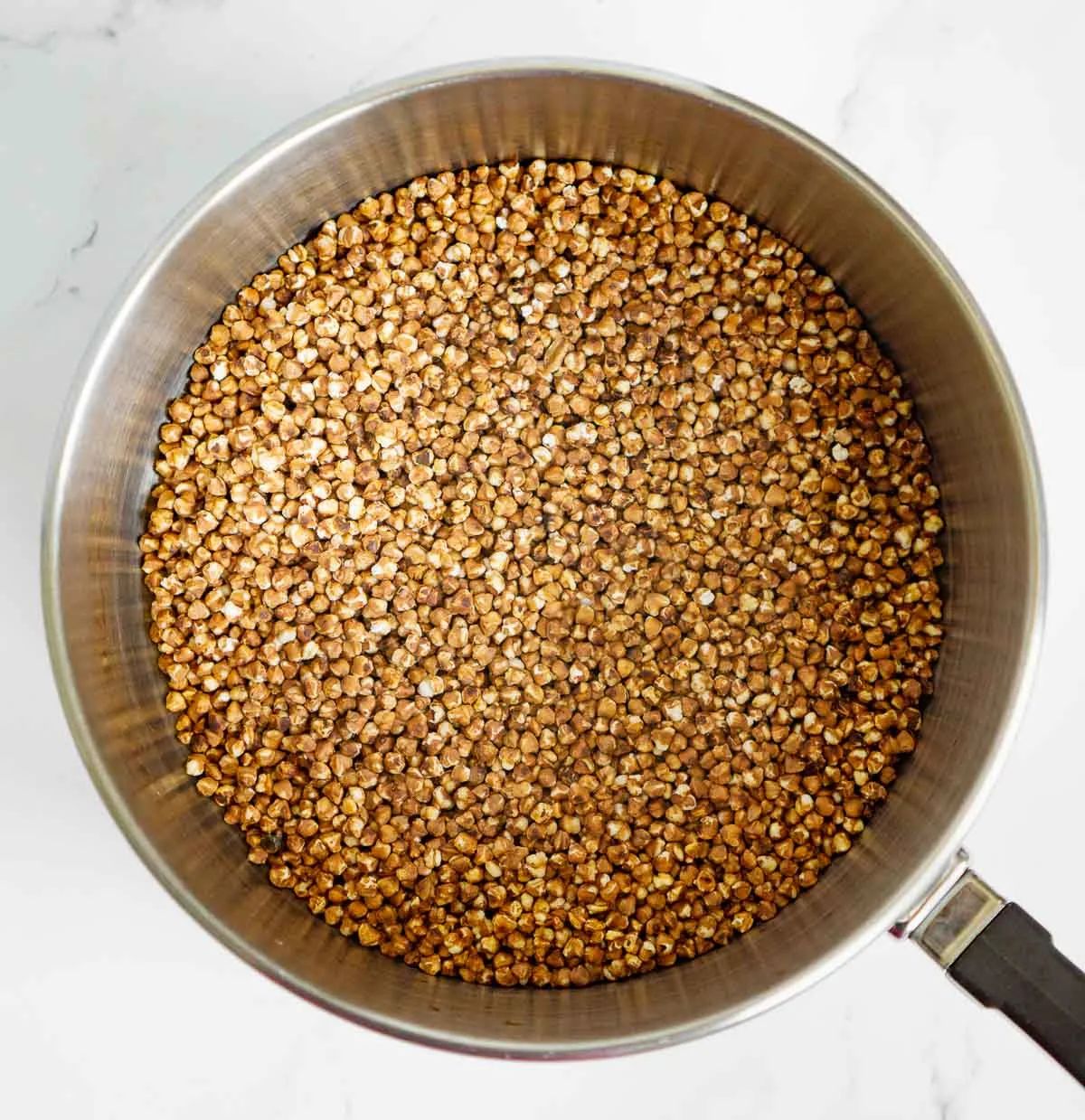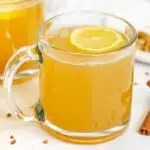Making toasted buckwheat tea at home is so easy! Buckwheat tea has a wonderful toasted nutty aroma. It can be flavored easily with a little lemon juice, honey (or maple syrup for a vegan buckwheat tea), and spices of your choice. Buckwheat tea is naturally gluten-free and caffeine-free, and is great hot or iced.
The best part about making buckwheat tea is that you can make tea for drinking and buckwheat for eating all in one step!! I'll give you all the tips for making buckwheat tea in a way so you can make a delicious meal from the buckwheat groats as well!

Jump to:
What is buckwheat tea?
Buckwheat tea is simply tea that was made by simmering buckwheat groats in water to impart that wonderful, earthy flavor into the water. It is made by draining the buckwheat out, sweetening the tea with a little honey (or agave or maple syrup or sugar), and flavoring it with a little lemon juice.
Buckwheat tea is commonly drank in Japan, where buckwheat is used to make popular soba noodles. Buckwheat tea is actually called "sobacha," which is a combination of the words "soba" and "ocha," which means tea (similar to "chai").
Buckwheat is a common ingredient in Ukraine and Russia, so we grew up eating a lot of buckwheat. I am not claiming this is an authentic sobacha recipe—think of this as a fusion of Japanese and Ukrainian/Eastern European food!

More hot drinks to try: Honey Lavender Latte
Is buckwheat tea healthy?
Buckwheat itself is very healthy. It is a gluten-free pseudo grain. Yes, despite the name, buckwheat is not related to wheat and does not contain gluten! Making tea from buckwheat is a great way to make homemade caffeine-free tea.
However, since the buckwheat itself is strained out and you are only drinking the water, it is hard to say whether any of the healthy components of buckwheat make it into the tea itself. Buckwheat tea is certainly not unhealthy! Enjoy it in moderation, just like all other food and drinks.
What does toasted buckwheat tea taste like?
Have you ever had roasted rice tea at an Asian restaurant? Toasted buckwheat tea has similar flavor notes—it is nutty, smoky, earthy, and very warming. And yes, it does taste like buckwheat! So if you are not a fan of buckwheat, then this might not be the tea for you.
This recipe starts by toasting dry uncooked buckwheat groats in a pan to release the wonderful toasty aroma before brewing the tea.
I find that buckwheat tea needs to be flavored with lemon juice and sweetened just a little with honey for it to taste really good.
Spiced buckwheat tea—flavor variations
In addition to flavoring your tea with lemon juice and honey, try adding any of the following to the water as the tea is cooking:
- Cinnamon stick (or a pinch of ground cinnamon)
- Dried star anise
- Few dried cloves
- A few slices of fresh peeled ginger, or sweeten the tea with honey ginger syrup
- Pinch of turmeric (add a pinch of ground black pepper to help with turmeric absorption!)
All these spices and seasonings add flavor, warmth, and antioxidants to your tea!
Of course, if you add these spices to your cooking water, it will also flavor the buckwheat groats that are being cooked. If you plan on eating the buckwheat after making buckwheat tea, you might want to plan on stick to a sweet buckwheat recipe, such as breakfast buckwheat, so that the sweetness complements the spices.
Related recipe: Hot Spiced Tea
Make iced or hot buckwheat tea
This tea can be served hot or iced. If serving hot, just wait until it is cooled down enough to sip safely. To serve it iced, sweeten and flavor the tea to your liking, then let it cool to at least room temperature. Place the tea in the fridge, then pour over ice. Adjust the flavor as needed with sweetener or lemon juice, since cold and hot drinks taste different to our taste buds!

How to cook buckwheat tea so you can eat the cooked buckwheat
The best part about this tea recipe is that you can have your tea and eat it too! 😉 No need to toss the cooked buckwheat groats after making tea!
Buckwheat tea is simply the water left over from cooking buckwheat! Typically when cooking buckwheat to eat as kasha, we add just enough water for it to get absorbed, and we season the cooking water with salt to flavor the buckwheat.
If you simply add extra water and do not add salt, you can use the extra water to drink as tea!
Just save the cooked buckwheat after straining it, then season the buckwheat how you like it: add some salt to make savory buckwheat bowls with vegetables, or buckwheat with roasted chickpeas and kale, varnishkes, or simply serve buckwheat as a side dish on its own.
If you want to add lemon juice, honey, and spices to the buckwheat tea as it is cooking, you can still use the cooked buckwheat and simply eat it as a sweet dish instead of a savory one.

Ingredients
- ¼ - ½ cup uncooked buckwheat groats*
- 5 cups water
- 2-3 tablespoons lemon juice (from 1 lemon)
- 2-4 tablespoons honey or maple syrup, to taste
- Optional spices and flavorings: cinnamon stick, anise star, few cloves, pinch or ground turmeric or sliced ginger (see the flavor variation tips above).
*How much buckwheat to use: ¼ cup buckwheat is enough to give this tea a nice buckwheat flavor. I like to use ½ cup for a stronger flavor, and so I can make a meal out of this too!
Equipment
You'll need the following:
- Medium pot (~3 quarts)
- Fine mesh strainer (or line a metal colander with a coffee filter or a paper towel)—you want to catch all the little bits of buckwheat so your tea is not grainy
Instructions
Step 1: Toast the buckwheat in a small saucepan ( over medium-high heat for 3-5 minutes, or until the buckwheat smells fragrant and starts to make a popping sound and starts to pop (by the way, popped buckwheat is delicious and tasty!). Make sure to stir often and not let the buckwheat burn and turn black.

Step 2: CAREFULLY add the water—it will start boiling and steaming IMMEDIATELY because you are adding it to a very hot pan. Optional: add a cinnamon stick, a dried anise star, dried cloves, a pinch of turmeric, and/or a few pieces of sliced peeled ginger to flavor the tea.
Step 3: Lower the heat and simmer for 5-10 minutes, or until the buckwheat is soft and cooked, and the buckwheat tea is a light brown color.
Step 4: Carefully strain the buckwheat through a fine mesh sieve into a 32-oz heat-safe jar or right into your cups. If you don't want cloudy tea, line the sieve with a coffee filter or paper towel.
Do not let the buckwheat sit in the hot water or it will absorb most of the water. Stir in some lemon juice and honey, to taste. Sip slowly and enjoy!! Or allow to cool, refrigerate, then pour over ice.
If the tea tastes "too buckwheaty," simply dilute it with some hot or cold water!

Would you try this tea??
If you enjoyed this recipe, let me know with a comment and a star rating below. And don't forget to share it on Facebook and save it on Pinterest for later!
Toasted Buckwheat Tea
Ingredients
- ¼ - ½ cup uncooked buckwheat groats - see notes
- 5 cups water
- 2-3 tablespoons lemon juice - or to taste
- 2-4 tablespoons honey or maple syrup - or to taste
- Optional spices and flavorings: cinnamon stick, anise star, few cloves, pinch or ground turmeric or sliced ginger - see notes
Special equipment
- Medium saucepan ~3 quarts
- Fine mesh strainer or line a colander with a paper towel
Instructions
- Toast the buckwheat in a small saucepan over medium-high heat for 3-5 minutes, or until the buckwheat smells fragrant and starts to make a popping sound and starts to pop. Make sure to stir often and not let the buckwheat burn and turn black.
- CAREFULLY add the water—it will start boiling and steaming IMMEDIATELY because you are adding it to a very hot pan. Optional: add a cinnamon stick, a dried anise star, dried cloves, a pinch of turmeric, and/or a few pieces of sliced peeled ginger to flavor the tea (read the notes below)
- Lower the heat and simmer for 5-10 minutes, or until the buckwheat is soft and cooked, and the water is a light brown color.
- Carefully strain the buckwheat through a fine mesh sieve into a 32-oz heat-safe jar or right into your mugs. If you don't want cloudy tea, line the sieve with a coffee filter or paper towel. Do not let the buckwheat sit in the hot water or it will absorb most of the water.
- Stir in some lemon juice and honey, to taste. If the tea tastes "too buckwheaty," simply dilute with some water. Sip slowly and enjoy!! Or allow to cool, refrigerate, and pour over ice, adjusting the flavor to taste.
Notes
Nutrition
The nutritional information displayed is an estimate and not to be used as dietary or nutritional advice. Consult a nutritionist or dietician for nutritional info based on the exact ingredients you use.


